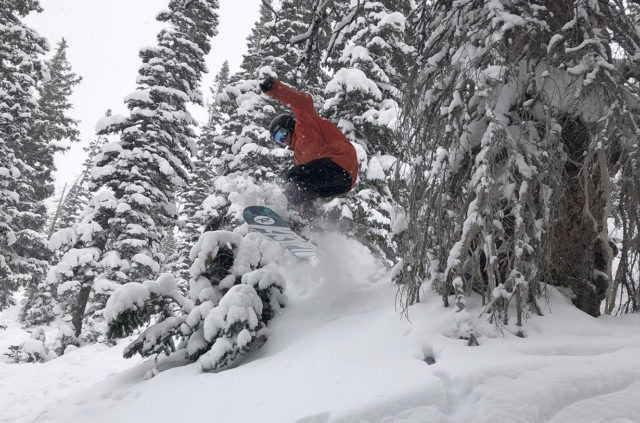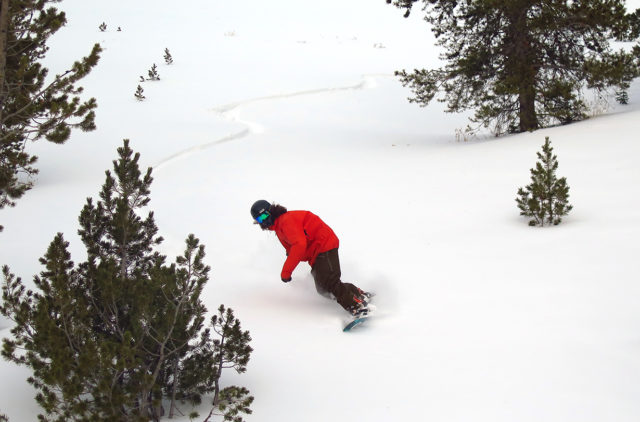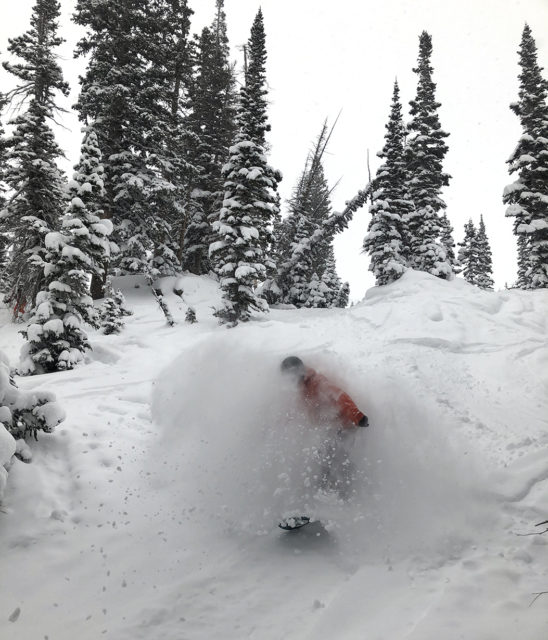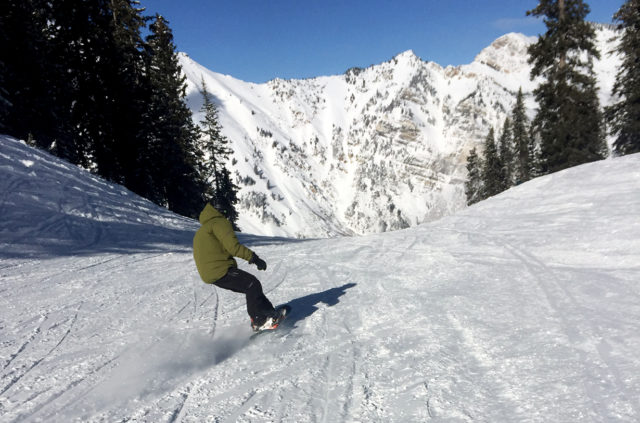Board: 2018-2019 Rossignol Krypto, 163 cm
Available Sizes: 156, 159, 163 cm
Stated Dimensions (163 cm): 290-252-290 mm
Stated Nose Length: 350 mm
Stated Tail Length: 220 mm
Stated Sidecut Radius (163 cm): 9.5 m
Stance Setback: 30 mm
Reference Stance: 21.2”
Camber Profile: “Amptek Elite Rocker” (20% rocker / 40% camber / 20% rocker)
Stated Flex Rating: 8/10
Core: Poplar/Birch + Fiberglass Laminate
Base: Sintered 7500
Bindings: Rossignol Experience, Burton Cartel
Boots: Burton SLX, Nike Kaiju
Stance: 22”, 15°, -9°
Reviewer: 6’2”, 165 lbs
Test Locations: Copper, CO; Snowbasin & Snowbird, UT; Boulder Mountains, ID
Days Tested: ~30

Intro
The Krypto is a longstanding figure in the Rossignol line. Originally designed as a softer-flexing version of a Jeremy Jones pro model, the Krypto has remained in Rossi’s line for years. So, what’s so special about the Krypto that Rossi continues to bring it back unchanged? After more than 30 days on it, I think there are plenty of good reasons…

Construction
The Krypto utilizes Rossi’s Twinwood core, which is composed of alternating strips of birch and poplar, and no carbon stringers. Though some might lament the lack of carbon, I actually think it’s one of the Krypto’s strong points.
Boards with lots of carbon are often really snappy but lose their dampness in the process, and in my opinion, too many manufacturers slap carbon stringers on boards that don’t need them. The Krypto’s lack of carbon makes for a relatively smooth ride, increased maneuverability, and it combines well with its camber profile (camber underfoot, rocker in the tip and tail).
Flex Pattern
Like many directional freeride boards, the Krypto starts soft in the nose and stiffens towards the tail. On the whole, it’s much softer than many other boards in its category (Rossignol rates the Krypto’s flex as an 8/10, but I’d put it more in the 6-7/10 range compared to the whole market). I’ve included some comparisons from outside the “freeride gun” category to better place the Krypto’s flex.
Flex — Nose
The Krypto’s nose flex is quite soft compared to other freeride boards, and is instead most similar to the Burton Modified Fish or even a park board like the Rossignol Jibsaw. The Krypto’s neighbor in the Rossignol line, Xavier De Le Rue’s “XV,” is so much stiffer it’s almost unfit for comparison. While the XV is stiffer tip-to-tail, the nose is where the two differ the most — the XV’s flex pattern relies on a stiff nose for driving through crud, while the Krypto’s nose is shockingly soft (and more damp as a result). The shovels on the Amplid Creamer and Burton Flight Attendant are also significantly stiffer than the Krypto’s.
Flex — Underfoot
Stiffening underfoot, the Krypto’s flex is more like the Rossignol Angus between the bindings. It’s stiffer in this zone than the Modified Fish, and is still softer than the Creamer, Flight Attendant, and XV.
Flex — Tail
The tail is the stiffest area on the Krypto, and it’s only slightly softer than the Flight Attendant here. It’s comparable to the Angus and is slightly stiffer than the Burton Antler.
Torsional Flex
The lack of carbon really shows in the Krypto’s torsional flex. It’s just slightly stiffer than the Jibsaw torsionally and is softer than the Antler, Angus, Creamer, Flight Attendant, and XV (ranked in order of increasing torsional rigidity).
Powder
The Krypto feels at home in softer snow. Its big, soft, rockered shovel make it relatively easy to stay afloat — even in the lightest of Utah’s blower pow. The Krypto is not tapered, so riding deeper snow is more back-foot-heavy than on a board like the Modified Fish, Rossignol XV Sushi, or K2 Cool Bean. That said, the Krypto’s mellow flex and shape leave me with no complaints in powder.

Chop / Variable Snow / Trees
The Krypto’s softer flex, paired with a decent amount of rocker in the nose, makes it more maneuverable in chopped-up, bumpy snow than stiffer freeride boards like the Rossi XV. On the Krypto, I didn’t find myself getting bucked around by unexpected patches of rougher snow, which I have noticed with boards with stiffer, often carbon-laminated noses. I definitely wouldn’t be as comfortable riding high-consequence lines on the Krypto than I would with a board like the XV, but the Krypto is a great board for 99% of resort riding at most mountains, and I took it everywhere at Snowbird without any problems.
The Krypto is a decidedly freeride-oriented board, but it’s also comfortable in the air. The tail rocker is mellow enough so that it doesn’t inhibit stability on landings, and though it isn’t the snappiest board, I’ve found the Krypto’s pop to be more than enough to crack little side-hit airs.

For larger airs and cruddy landings, I’d prefer a board with a stiffer tail like that of the Burton Flight Attendant. But since the Krypto is softer than many freeride boards, it’s a lot of fun in tight terrain. The Krypto’s shape is forgiving in chop and rough snow, but the flex makes it very maneuverable in tight trees and chutes.
Groomers / Hardpack
The Krypto feels solid on hardpack. With camber underfoot and rocker beginning from just outside the inserts, it offers plenty of effective edge on harder snow (Rossi claims 1220 mm of effective edge for the 163 cm version).

The Krypto’s shovel isn’t noticeably catchy on hardpack, and the slightly decreased effective edge from the rocker makes it maneuverable and comfortable with short-radius turns. Rossignol has used Magne-traction for over a decade now, and though it’s now renamed “serrated edges,” the Krypto features this technology. I’m a fan of this sort of serrated sidecut design — I think it does increase edge hold and doesn’t sacrifice much smoothness in the process. Some find it catchy and difficult to ride, but I’ve never had such issues after a brief break-in period.
I have had some slight issues with the Krypto’s width. The 163 cm version’s waist is a stated 252 mm, which definitely puts it on the narrower end of the spectrum. I have fairly large feet at size 10, and I definitely had some serious issues with toe drag on the Krypto when carving at higher edge angles on groomers, especially in the spring when the snow was soft. That said, it’s worth noting that the Krypto is offered in a “wide” version, with a stated waist width of 261 mm.
Comparisons
The Flight Attendant’s camber profile (camber from the front inserts to the tail) and shape (twin sidecut profile with a tapered shovel) are decidedly different from the Krypto, which has both tip and tail rocker, a directional sidecut, and no taper in the shovel.
The Flight Attendant’s stiffer, cambered tail provides better stability when landing in rough snow, and it’s more comfortable with larger-radius turns on hardpack. The Flight Attendant is overall much stiffer than the Krypto, takes more effort to ride, and is less maneuverable in tight chutes and trees.
Switch riding is one of the Flight Attendant’s strengths, and the Krypto’s directional shape makes riding switch less than ideal. While these are both freeride-oriented boards, the Krypto is best suited for slower speeds, softer snow, less airtime, and more playful riding. The Flight Attendant is a better choice for those who want all-mountain freestyle performance and who are willing to sacrifice playfulness.
Amplid Creamer (2014-2015)
The Creamer is a no-frills freeride board, similar to the Krypto. The Creamer, like the Flight Attendant, lacks tail rocker. The Creamer’s shovel is stiffer than the Krypto’s, and its tip rocker is less dramatic. Unsurprisingly, the Creamer is also more comfortable on hardpack. The Creamer has a directional shape and is much less comfortable riding switch than the Flight Attendant, but is more versatile than the XV. Those who want a traditional directional board on the stiffer side should lead towards the Creamer, while those looking for maneuverability and playfulness will appreciate the Krypto’s softer flex pattern.
While the XV and Krypto are Rossignol’s top two freeride boards, they’re designed for completely different riders. The XV is a hard-charging, directional freeride gun designed for big lines. The Krypto’s softer shovel and lack of carbon throughout makes it considerably less stable at high speeds, and more at home surfing through trees and making quicker turns. Riders looking to charge steep, high-consequence lines should turn to the XV, while the average rider looking for a do-everything, directional resort board will be better off with the Krypto.
Who’s It For?
The Krypto is a freeride board for those who want to ride a variety of terrain but don’t want an extremely stiff, unforgiving charger. Its directional shape, serrated edges, and mellow camber profile make it a solid choice for all-mountain riding. Those in need of top-tier stiffness, responsiveness, and stability at high speeds on steep terrain will likely find the Krypto too floppy. It’s unable to plow through cruddy snow with the dependability that stiffer boards offer. But the Krypto is a great option for intermediate riders looking to try a freeride shape, or for those who have tried stiffer directional boards and found them to be difficult to control.
Bottom Line
The Rossignol Krypto refreshingly bucks the trend of overly stiff freeride boards. It offers a playful flex with dampness in chop, quick edge transitions in trees, and shorter-radius turns on hardpack. It’s not for the most aggressive of big-mountain riders, but for everyone else, it’s a lot of fun to ride in a variety of terrain and snow conditions.
